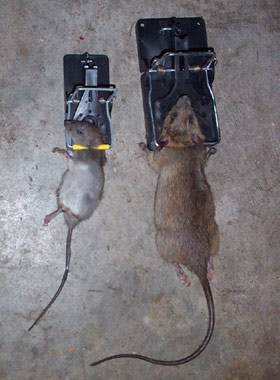| |
|
|
Rat Removal and Control in Seattle
|
Norway Rat Biology: Rattus norvegicus - also known as the Brown Rat or Common Rat. This rat is the larger of the two, and prefers to live at ground level. This rat can measure up to ten inches with a ten inch
tail, and males can reach up to 1.5 pounds. They are not good climbers, but can dig well. They have poor vision, but an excellent sense of smell. A female Norway Rat can breed year-round, and produce up to five litters
of young per year. Each of these litters averages 5-10 members. The gestation is only 3-4 weeks, and the young are sexually mature in only 3-4 months. For these reasons, rat populations, like that of many rodents,
can quickly proliferate. However, rats usually don't last long in the wild, rarely more than a single year, due to heavy predation and competition from other rats.
Roof Rat Biology: Rattus rattus - also known as the Black Rat. This rat is smaller and less aggressive than the Norway. It spends 90% of its life above ground, usually in trees, on power lines, and in attics of
homes and buildings. Many aspects of its biology are similar to the Norway. They reproduce very quickly, they are nocturnal, they have poor vision, and a great sense of balance. They primarily eat grains and cereals,
as well as fruits, nuts, and pretty much anything, if need be. Where they cohabitate, the Norways are more dominant, and often wipe out the Roof Rats. However, sometimes Norways will live under a house or at
ground level, while the Roof rats live in the attic. |
|
 |
Nuisance Concerns: Rats are a nuisance species for many reasons. The first complaint that most people have is due to the noise they cause scurrying about and scratching inside the home. Many people don't call
to have their rat problem solved until the rats break into the home proper and start to chew on and contaminate food items in the house. However, if you've got rats in the attic or walls, they are causing many problems.
First of all, rats chew and gnaw all of the time to wear down their rodent teeth. They often chew on electrical wires, creating a potential for shorts or fire hazards. They also leave a lot of feces and urine, and can
contaminate a home. Rats carry a variety of diseases, such as Rat-bite fever (Streptobacillus moniliformis bacteria), Rickettsia virus, Hantavirus, Eosinophilic Meningitis. The droppings of rats can cause Leptospirosis
or Salmonellosis.

This is a professional wildlife removal company based in Seattle Washington. We provide pest control for wild animals only, not extermination of insects. If you have nuisance critters that you need to
get rid of, we can humanely take care of the problem.
We specialize in the removal of rats buidlings, particularly from crawl spaces and attics of homes. It's very common for rats to enter and live in the attic. For more information on rats living in attics, visit this
rats in attic website, made by my friend, who trained me on rat removal.
You Found Rat Droppings Or Mouse Droppings, What now? - Finding rat droppings or mouse droppings anywhere in your home can be a cause for concern. Where are they hiding? Do these mice carry disease? There are some places where you will be more likely to find droppings and they include the attic, basement and anywhere that you store food that they can get into. That is why it is important to make sure those cabinets and pantries are secured so that you do not end up getting a family of mice living near their steady food source.
When you find the mice droppings or mouse droppings in your home you should do a few things first. You should check all food items to make sure that they have not been tampered with, if they have been, then throw them away. Clean the place where the droppings were found with a good cleaner. You can then use some sort of repellent to make sure that they do not come back, and if they do then perhaps it is time to call an exterminator. You can have an idea of how many mice are in your home because of the droppings. It is possible that it is a single mouse, but in most cases there will be more than one.
| | |